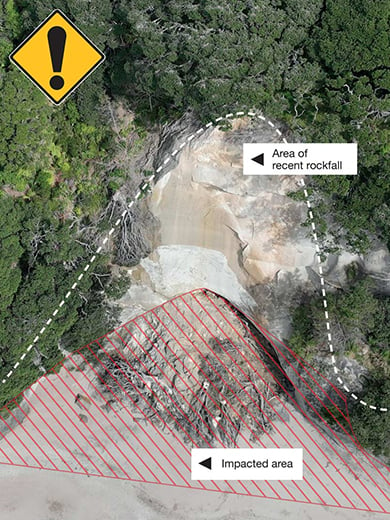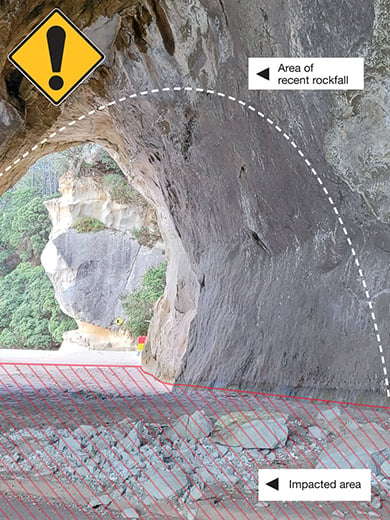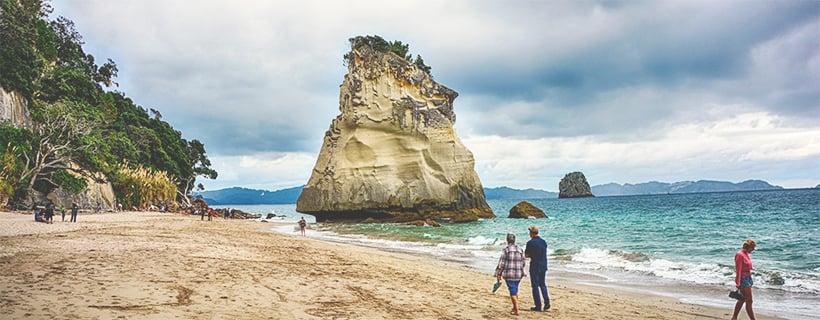5 km (return)
Do not visit during or after heavy rain, due to the risk of landslides and rockfall.
The beach gets crowded in summer. Go at low tide when there’s more space. Only visit when the sea is calm. Check tide times and sea conditions
Image gallery
The track starts at the top of Grange Road. Plan your transport, as there is no parking at the track entrance.
It follows the coastal hilltops through both forest and open grass areas. The track descends steeply as it approaches the Mares Leg Cove and Mautohe Cathedral Cove beaches. The track ends at Mares Leg Cove beach, where you can view the rock arch through to Mautohe-Cathedral Cove beach.
The track is well formed but has steep sections and steps. It needs moderate to good fitness and sturdy footwear. It can be very hot in summer and there is no running water, so bring plenty of water and sun protection.
The tracks to Gemstone Bay and Stingray Bay are closed. They were damaged by Cyclone Gabrielle in 2023. Do not use these tracks.
This area is bordered by Te Whanganui-o-Hei/Cathedral Cove Marine Reserve. The ocean and all life within it are fully protected.
Toilets
There are toilets at the track entrance and around 10-15 mins before you reach the beach. There are no toilets on the beach. Respect the area by using the toilets provided.
Alternative routes
You can choose to take a farm walk on the privately-owned Cathedral Cove Gateway Trail (paid parking) at 150 Lees Road. The farm walk starts at Lees Road and connects with the main Cathedral Cove walking track.
If you want to visit Mautohe Cathedral Cove without hiking the track, you can view or reach the cove by water. There are commercial operators who run trips, or you can land a private kayak or other vessel on the beach.
Side track to Tokawhakairo McHands Lookout (25 mins return, 1.25 km)
You can also take a side track to the Tokawhakairo McHands Lookout. This turns off the main Mautohe Cathedral Cove track and the lookout has expansive views over Te Whanganui-o-Hei Mercury Bay.
There are steep drops along this track. Stay on the track and keep away from cliff edges. Supervise children carefully at all times. Expect strong winds.
Rockfall and landslide risks in this area
The Mautohe Cathedral Cove landscape is naturally unstable. Rockfalls and landslides could cause serious injury or death. Read the Know before you go section to decide whether this trip is right for you, and to learn how to reduce the risk.
The nearest towns are Hahei (2 km), Whitianga (35 km) and Coromandel (54 km).
The track begins at a drop-off area at the top of Grange Road. There is currently no parking at the start of the track.
You can also reach the main Mautohe Cathedral Cove walking track by taking the privately-owned Cathedral Cove Gateway Trail. This starts at a car park (paid parking) at 150 Lees Road, Hahei.
The track from Hahei Beach to the Grange Road track entrance (Hahei Beach Walk) is closed due to ongoing land instability. For your safety, do not use this track.
There are also commercial tour options available.
Parking information
Free parking is available at the Hahei Visitor Carpark, near the entrance to Hahei village. You can catch a park and ride shuttle bus from there. There is also the option of walking up Grange Road to reach the track entrance, which takes roughly 30 mins. It has a long uphill section and there is little shade.
Mautohe Cathedral Cove Track parking information (PDF, 3,108K)
Check the conditions before you set off.
In the event of bad weather – such as heavy rain or cyclones - the reserve/track may be closed at short notice based on DOC staff assessments.
Any closures are based on processes and factors outlined in this media release.
Rockfall and landslide risks
The Mautohe Cathedral Cove landscape is unstable. Rockfalls and landslides could cause serious injury or death. The risk is highest during or after heavy rain, but is still present in good weather. Learn how we assess risk in this area
Understand the risk before visiting and decide whether the trip is right for you.
To reduce the risk:
- do not stop or sit near the cliffs
- do not stop under the rock archway – move quickly through it
- do not visit during or after heavy rain.
The best time to visit is low tide, as that is when there is the most space on the beach away from the cliffs.
Examples of rockfall and landslides at Mautohe-Cathedral Cove:

Landslide on the beach | Image: DOC

Rockfall from the arch | Image: DOC
Stay safe in the water
The beaches at Cathedral Cove are wild and are not patrolled by lifeguards. Many people have got into trouble in the water here.
There are rip currents in the bay. There can be big waves. Boats, kayaks and jet skis sail in the bay and land on the beach. The archway and parts of the beach become impassable at higher tides or during big swells.
Stay safe in and around the water when visiting Mautohe Cathedral Cove:
- Stay out of the archway when there is water in it.
- Watch for incoming tides. You could get cut off and not able to go back through the archway.
- Visit at low tide and when the seas are calm. You can check the tide times and the sea conditions.
- Supervise children at all times.
What to take
Bringing the right things on your hike to Mautohe-Cathedral Cove helps you have a great time.
We recommend you wear:
- sturdy and comfortable footwear with good grip, like sneakers or light hiking shoes. Jandals are not suitable for this track.
- clothes that provide protection from the sun. For example, lightweight long-sleeved tops.
- a sun hat
- sunglasses
- sunscreen.
You should also bring:
- plenty of water. The hike can be very hot, as there is no shade, and there is no running water available.
- portable shade, eg an umbrella or beach tent
- snacks
- a raincoat and warm clothes
- a fully charged mobile phone
- a bag or container to take your rubbish away with you.
Find a full day hikes packing list at Day Hikes gear list.
Keep Mautohe Cathedral Cove clean
There are no rubbish bins at the Cathedral Cove beach, track and car park. Take all your rubbish away with you, including food scraps.
Use the toilets provided.
You stand in a place of deep significance to Ngāti Hei – graffiti on the cliffs or rock arch is taken as a sign of disrespect.
Steep drops and strong winds
There are steep drops and strong winds on the Tokawhakairo McHands Lookout track.
Stay on the track and keep away from cliff edges. Supervise children carefully at all times. Expect strong winds.
This blend of land and marine ecosystems makes Cathedral Cove a unique and fascinating destination for naturing.
Native trees along the track include punga, harakeke, kawakawa, māpou. There are pōhutukawa on the beach.
It’s home to native birds like the tūī and kererū. You might also spot fantails flitting about and hear the distinctive call of the bellbird.
Marine Reserve
The area is also renowned for its rich marine life, including species like snapper, crayfish, and the colourful clown nudibranch. The area is within Te Whanganui-o-Hei/Cathedral Cove Marine Reserve and is home to vibrant sponge gardens and diverse reef systems.
Be sure to take care of this fragile protected place. No fishing or killing marine life. No taking marine materials. No feeding fish.
Unique geology
Although Coromandel Peninsula is formed from some of the oldest sedimentary rocks in New Zealand (around 150 million years old), the coastline and islands around Te Whanganui-o-Hei were only formed about 8 million years ago from volcanic eruptions. These eruptions produced two kinds of rock: rhyolite and ignimbrite. They formed some amazing features both below and above the water.
Ignimbrite is a mixture of volcanic ash and pumice; it is the light-coloured rock at Cathedral Cove. This rock is prone to erosion, so structures such as Mautohe Cathedral Cove and Te Hoho Rock have formed over time.
Rhyolite is formed from lava and is more dense and darker in colour. It can be seen on the islands and further down the coast.
Some of these islands, such as Castle Island, are remnants of the molten magma at the centre of the volcanoes – these are often referred to as volcanic ‘plugs’.

Mautohe Cathedral Cove
Image: Mariano Mantel | Creative Commons
This place is deeply significant to Ngāti Hei, who have lived here for generations and have an unbroken connection to both the rohe whenua and rohe moana (tribal estate land and sea).
As kaitiaki (guardians) of this rohe (area), Ngāti Hei ask you to bring an awareness of the power of nature with you when you visit.
When you visit, remember you are not just a guest – you are a guardian of this place.
The waters that border this recreation area are a marine reserve, where the ocean and all life within it are fully protected.
In Te Ao Māori, the sea is a living ancestor. By actively respecting this marine reserve, we honour the mauri (life force) of the ocean and its marine creatures and support them to thrive, regenerate and flourish.
These protected waters are not simply a place for recreation – they’re living classrooms and also provide vital habitats for many species.
Nature's in trouble
Thousands of New Zealand’s native species are heading towards extinction. Once they’re gone, they’re gone for good. Nature needs your help.
Kauaeranga Visitor Centre
| Phone: | +64 7 867 9080 |
| Email: | kauaerangavc@doc.govt.nz |
| Address: | 995C Kauaeranga Valley Road Thames 3577 |
| Hours: | Visitor centre hours and services |
DOC Customer Service Centre
| Phone: | 0800 275 362 |
| Email: | coromandeldistrict@doc.govt.nz |
| Address: | Whitianga Base |
